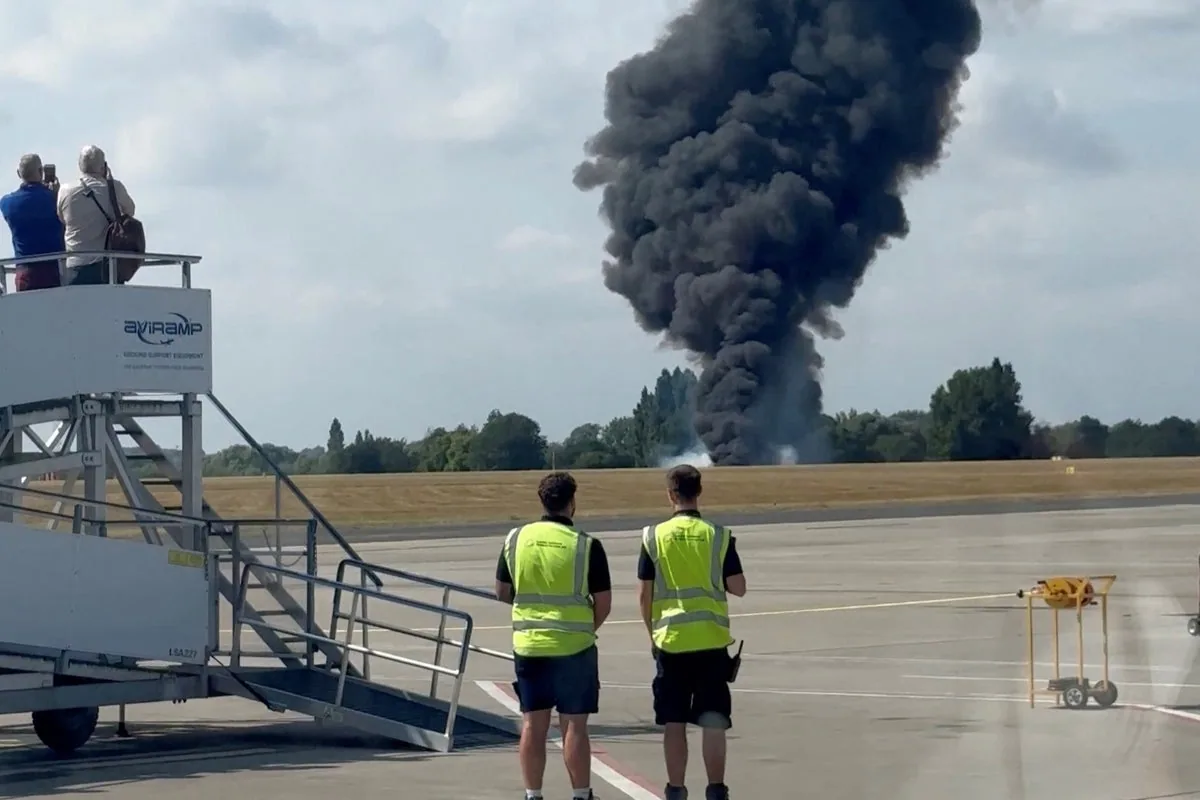
Introduction
On the morning of iulie 10, 2025, a routine flight from London Heathrow took a sudden and terrifying turn. Just minutes after takeoff, the aircraft—carrying 178 people—crash-landed in an open field barely a mile from the runway. Thick smoke rose over west London as emergency alerts sounded across the airport.
What followed was one of the most efficient emergency responses the city has ever seen. Within minutes, roads were cleared, sirens echoed, and dozens of first responders were racing toward the wreck. Their speed and coordination saved lives. Here’s how it happened.
Ce s-a întâmplat: A Quick Recap of the London Plane Crash
At 8:43 a.m., Flight LDN328, a Boeing 737 bound for Frankfurt, issued a mayday. Both engines had failed. The pilots attempted an emergency return, but the plane lost power entirely before it could reach the runway.
Just four minutes later, at 8:47 a.m., the aircraft crash-landed in a grassy embankment near the eastern perimeter of the airport. Debris scattered across the field, passengers ran for safety, and smoke filled the sky. Despite the severity of the crash, 92% of those onboard survived—thanks in large part to what happened next.
Emergency Teams on the Scene: Who Responded First?
By 8:44 a.m., one minute after the mayday, air traffic control had notified the London Fire Brigade’s Airport Division. Emergency crews were already mobilizing before the plane even hit the ground.
Here’s how fast responders arrived:
- Heathrow Airport Fire & Rescue: on site by 8:49 a.m.
- London Ambulance Service: first ambulances arrived by 8:51 a.m.
- Metropolitan Police: reached the area and redirected traffic by 8:55 a.m.
- British Transport Police: cleared nearby rail lines and evacuated a halted train
Heathrow’s fire crews were first to reach the wreck. Foam cannons tackled the blaze, while firefighters pried open emergency exits to reach survivors. This wasn’t luck—it was well-drilled readiness in action.
Rapid Coordination: How Agencies Worked Together
The moment Flight LDN328 declared an emergency, a pre-established crash response plan kicked in. London follows a well-rehearsed Aircraft Accident Emergency Plan—and it showed.
Once the alert was issued:
- Air traffic control declared a Level 3 emergency, triggering a full crash response
- Police, ambulance, and fire dispatchers were connected through a shared radio network
- Command centers were established both at the scene and at Heathrow HQ
Each team stuck to its role: firefighters led rescue, paramedics handled medical triage, and police secured the site and directed traffic. The response was fast, efficient, and coordinated.
Life-Saving Actions Taken Within the First Hour
By 9:00 a.m., over 60 emergency personnel were working the crash site. Passengers were pulled from the wreck and guided to triage points. Teams moved quickly through heavy smoke and scattered debris.
Injuries were assessed and sorted using a basic color-coded system:
- Red: critical
- Yellow: serious, but stable
- Green: minor
Paramedics treated survivors on site before transporting them to four nearby hospitals. Air ambulances were dispatched for the most severe cases. By 9:12 a.m., the fire was out. By 9:30 a.m., federal investigators had arrived.
Technology and Tools That Helped Speed Up the Response
Technology played a key role in getting help to the scene quickly and keeping operations smooth.
Tools that made a difference included:
- GPS tracking in every emergency vehicle, allowing command centers to dispatch units efficiently
- Thermal drones, which searched the wreckage for heat signatures
- Mobile command vans, equipped with live air traffic and weather feeds
- Flight data signals, which helped investigators find the black boxes within hours
Even traffic light systems were overridden to clear paths for ambulances and fire trucks. Those few saved minutes mattered.
What Officials Said About the Response Efforts
Later that day, London Fire Commissioner Samantha Reed said, “This is what we prepare for. Everyone did their job.”
Mayor Oliver Grant praised the teamwork, calling it “a textbook emergency response.”
Survivors took to social media to thank first responders, describing them as “calm under pressure” and “absolute heroes.” The Prime Minister also credited the coordinated effort, saying it prevented what could’ve been a far greater tragedy.
Lessons Learned and Future Preparedness
While the response was praised, debriefings revealed a few areas for improvement. The main issue: brief communication lags caused by overloaded radio channels during the first few minutes. Plans are now in motion to back those systems up with satellite-based networks.
Other takeaways included:
- The value of joint drills between airport and city responders
- Need for improved public knowledge of evacuation procedures
- Continued investment in digital command systems to avoid bottlenecks
City leaders say other major hubs are already reviewing London’s model to adopt similar response frameworks.
Conclusion
The crash of Flight LDN328 could have ended much differently. But thanks to training, coordination, and split-second decisions, hundreds of lives were saved.
This wasn’t just a show of bravery—it was proof that detailed planning, clear communication, and teamwork are essential when disaster strikes. London’s emergency crews didn’t just respond—they responded right.
And that made all the difference.




Leave a Reply